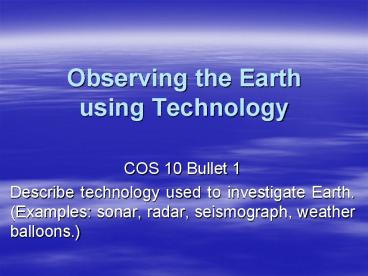Observing the Earth using Technology - PowerPoint PPT Presentation
1 / 27
Title:
Observing the Earth using Technology
Description:
Observing the Earth using Technology COS 10 Bullet 1 Describe technology used to investigate Earth. (Examples: sonar, radar, seismograph, weather balloons.) – PowerPoint PPT presentation
Number of Views:36
Avg rating:3.0/5.0
Title: Observing the Earth using Technology
1
Observing the Earth using Technology
- COS 10 Bullet 1
- Describe technology used to investigate Earth.
(Examples sonar, radar, seismograph, weather
balloons.)
2
The History of Observing Objects from Afar
- Navigators began experi-menting with ways to
observe the stars and planets during the
nineteenth century.
3
- One example to obtain long-range photographs was
to attach a camera to a pigeon.
4
- During the American Civil War, balloons were
lifted during battles to see the placement of
enemy troops.
5
- During the First World War, unarmed observation
planes would take off with a camera strapped to
the undercarriage.
6
- As technology progressed, it became possible to
use Sonar, Radar, the seismograph, and orbiting
satellites.
7
- SONAR
- SONAR is an acronym for SOund NAvigation and R
anging.
SONAR is a technique that uses sounds under
water to navigate, communicate or to detect other
vessels.
8
Exploration by SONAR
Sonar image of the USS Monitor on the ocean
floor.
- Shipping lanes on the nation's waterways are
continually shifting. Surveyors create maps of
the bottom of rivers, lakes, and oceans using
Sonar. No matter the method used, the resulting
maps are used to aid in maritime navigation,
scientific research, sports, and mineral
exploration.
9
- Surveyors observe the oceans floor for
volcanoes and other features that stick up above
the surrounding seafloor.
http//www.punaridge.org/doc/factoids/DigitalData/
Default.htm
10
RADAR is an acronym that stands for RAdio
Detection And Ranging.
- Radar is a system that uses electromagnetic
waves to identify the range, altitude, direction,
or speed of both moving and fixed objects such as
air craft, ships, motor vehicles, weather
formations, and terrain.
11
- A transmitter emits radio waves, which are
reflected by the target and detected by a
receiver, typically in the same location as the
transmitter.
12
- A weather Radar consists of a parabolic dish (it
looks like a satellite dish) encased in a
protective dome and mounted on a tower of up to
five stories tall.
Exploration by Radar
Example of a Radar image
13
- A meteorologist uses images that are received by
Radar to give information about the weather.
When looking at a weather map, a meteorologist
needs to know where the cold air is, where the
warm air is, where it is raining, what type of
clouds are in the area, and many more things..
Forecasts need to be timely and accurate and
radars give meteorologists detailed information
very quickly.
14
- This is a location map for the Radar sites.
15
- Earthquakes generate seismic waves which can be
detected with a sensitive instrument called a
seismograph.
http//www.thetech.org/exhibits/online/quakes/seis
mo/
16
http//en.wikipedia.org/wiki/Seismograph
- This is a Strong Motion seismometer that
measures acceleration. This model is a K2 made by
Kinemetrics and part of the Pacific Northwest
Seismograph Network.
17
http//www.answers.com/topic/kinemetrics-seismogra
ph-jpg
- Seismometers measure and record the size and
force of seismic waves. By studying seismic
waves, geologists can map the interior of the
Earth, and measure and locate earthquakes and
other ground motions.
18
http//cse.ssl.berkeley.edu/lessons/indiv/davis/hs
/Seismograph.html
- Ever since people first became curious about
earthquakes, they have tried to design some kind
of seismograph. This seismograph can be built
will some simple materials.
19
- A weather or sounding balloon is a balloon which
carries instruments aloft to send back
information on atmospheric pressure, temperature,
and humidity by means of a small, expendable
measuring device called a radiosonde.
Close up of a hydrogen filled balloon at
Cambridge Bay Upper Air station, Nunavut, Canada
http//en.wikipedia.org/wiki/Weather_balloon
20
- Twice a day, every day of the year, weather
balloons are released simultaneously from almost
900 locations worldwide! - This includes 92 released by the National
Weather Service in the US and its territories.
21
- As the balloon climbs it encounters lower air
pressure which causes it to expand to many times
its original size. Eventually the balloon bursts
and the radiosonde falls back to the surface.
The Balloon-Borne Sounding System or BBSS
22
- A radiosonde measures various atmospheric
parameters and transmits them to a fixed
receiver.
The radiosonde that falls back to the Earths
surface.
23
- As technology progressed, it became possible to
use orbiting satellites.
The United States launched its first weather
satellite, TIROS 1, in 1960.
http//space.skyrocket.de/index_frame.htm?http//w
ww.skyrocket.de/space/doc_sdat/tiros.htm
24
http//noaasis.noaa.gov/NOAASIS/ml/genlsatl.html
- GOES (Geostationary Orbiting Environmental
Satellite) orbit the earth at the same rate that
the earth rotates. It always sees the same area
of the earth and stays at the same point over the
equator.
25
- POES (polar orbiting environmental satellite)
scans the earth from north to south. As the
earth rotates on its axis, the satellite is able
to scan an area farther to the west with each
pass.
http//noaasis.noaa.gov/NOAASIS/ml/genlsatl.html
26
www.primidi.com/images/cosmic_satellites.jpg
www.newscientist.com/.../dn9311/dn9311-1_600.jpg
- Scientists use the information that they acquire
from Space for geology studies, agriculture
studies, meteorology, etc.
27
- The moon is Earths only natural satellite.
Observing the moon can be accomplished by using a
variety of instruments ranging from the naked eye
to large telescopes.
Moon as seen through a telescope
Moon as seen with a pair of binoculars
Moon as seen with the naked eye
http//www.netaxs.com/mhmyers/moon.tn.html
http//en.wikipedia.org/wiki/Observing_the_Moon
http//www.etsu.edu/physics/etsuobs/starprty/21200
mwc/moontour.html































